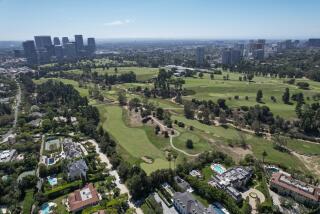Fairways Are Jammed on the Continent’s Busiest Golf Course
- Share via
SPAARNWOUDE, Netherlands — By American standards, the 25 groups in line at the automatic ticket machine at 6:45 on a sunny Saturday morning is not too bad.
But it is enough to make Spaarnwoude the busiest golf course on the European continent. Annually, 72,000 golfers play a round on the 18-hole course--that’s about one player every three minutes, 365 days a year. The complex is never closed.
Just over 10 years ago, this 210-acre golf emporium 10 miles west of Amsterdam was little more than a patchwork of meadows-turned-holes, squeezed between the Dutch capital’s port, a steel mill, and several four-lane highways.
“Only the smallest number of aficionados knew that we were here,” said Peter Blokhuis, an official of the agency responsible for the management and maintenance of the Netherlands’ first public golf course.
But in the early 1980s, business boomed, reflecting the mushrooming Dutch interest in golf, a pastime until then reserved for the wealthy playing on exclusive courses.
From 1980 to 1988, the number of Dutch amateur golfers rose from 11,380 to 36,630, with 80,000 players forecast for 1993, according to the Dutch Golf Association.
The rising popularity of the game was spurred by heavy media coverage of the annual Dutch Open Golf Tournaments, which earlier in the decade grew from a second-rate event to a full-fledged $517,500 PGA tourney, featuring stars like Tom Watson and Seve Ballesteros.
Blokhuis said that, “In the boom years, we were the only public golf course” in the western Dutch urban crescent running from Rotterdam via The Hague to Amsterdam and Utrecht in the central Netherlands.
“In other words, we served 2.5 million to 3 million potential customers of whom tens of thousands have gotten their first taste of golf on Spaarnwoude,” said Blokhuis in a recent interview. Now, three of the western Netherlands’ 13 courses are public.
The level, thickly wooded par-69 course, designed with some nasty water hazards by the late British golf architect Frank Penning, was built in 1977-1979 as part of a 6,669-acre recreational area that also features parks, playgrounds, camping sites and marinas.
Managed by the Spaarnwoude Recreational Authority, the golf complex is co-owned by five neighboring municipalities--among them Amsterdam--as well as the provincial and national governments.
Apart from the 6,000-yard 18-hole course, it boasts a 9-hole, par-27 training course and a 12-hole “chip” course, where an annual 10,000 novices have a first go at the game. In all, some 122,000 rounds were played on those three courses in 1988, according to Blokhuis.
In western Europe, only the Huppelrath private golf club near Dusseldorf, West Germany, comes close, according to a survey by AP bureaus around the Continent. An estimated 100,000 rounds were played on its two 18-hole courses, said manager Wilhelm Aldag.
“Compared to private golf clubs, the threshold is incredibly low here,” said Wim Smits, Spaarnwoude’s course manager. “It’s a real golf democracy.”
The green fee for the 18-hole course is $11 during weekends, and on weekdays it’s only $8. A round on the chip course costs a mere $2.25, while a bag with seven clubs is for rent for $6.65 a day.
For membership of the private Kennemer Golf and Country Club nearby, there’s a three-year waiting list, a joining fee of $1,335 plus an annual subscription fee of $400 dollars, a spokesman for the club said.
“I think I’d never have played golf if I hadn’t discovered Spaarnwoude,” said Jan de Jong, a shoe store employee from Haarlem, 6 miles to the southwest, during a 15-minute wait for his turn to tee off on the par-4 fifth.
“The private clubs are far too snobby and expensive for someone working in a shop,” De Jong said. He rented his first bag here “as a joke” five years ago, and now his handicap is 32.
“The only drawback is that it’s terribly busy, especially in summer,” said De Jong, who each Saturday morning drives to Spaarnwoude in pajamas to reserve a slot for the next Saturday, seven days away.
To counter the flood of new players expected in the 1990s, Spaarnwoude has embarked on an ambitious $1.9-million program which calls for nine more full-length holes and a doubling of the training course to 18 holes.
“We figured we’d rather extend our capacity than double our green fees,” Smit said. “This course was built with public money, so it should remain easily accessible to the general public.”
More to Read
Go beyond the scoreboard
Get the latest on L.A.'s teams in the daily Sports Report newsletter.
You may occasionally receive promotional content from the Los Angeles Times.










